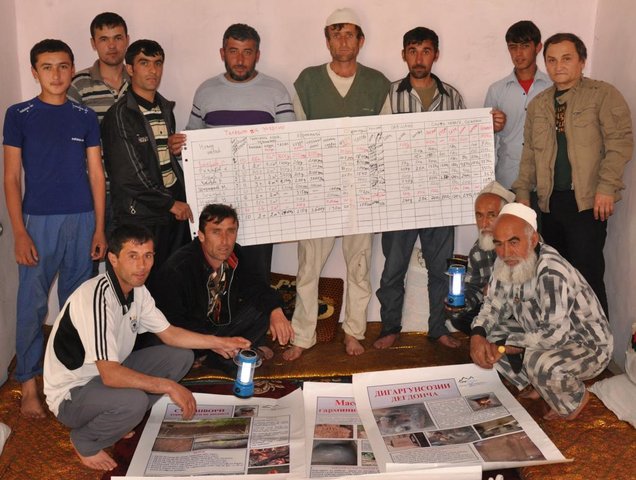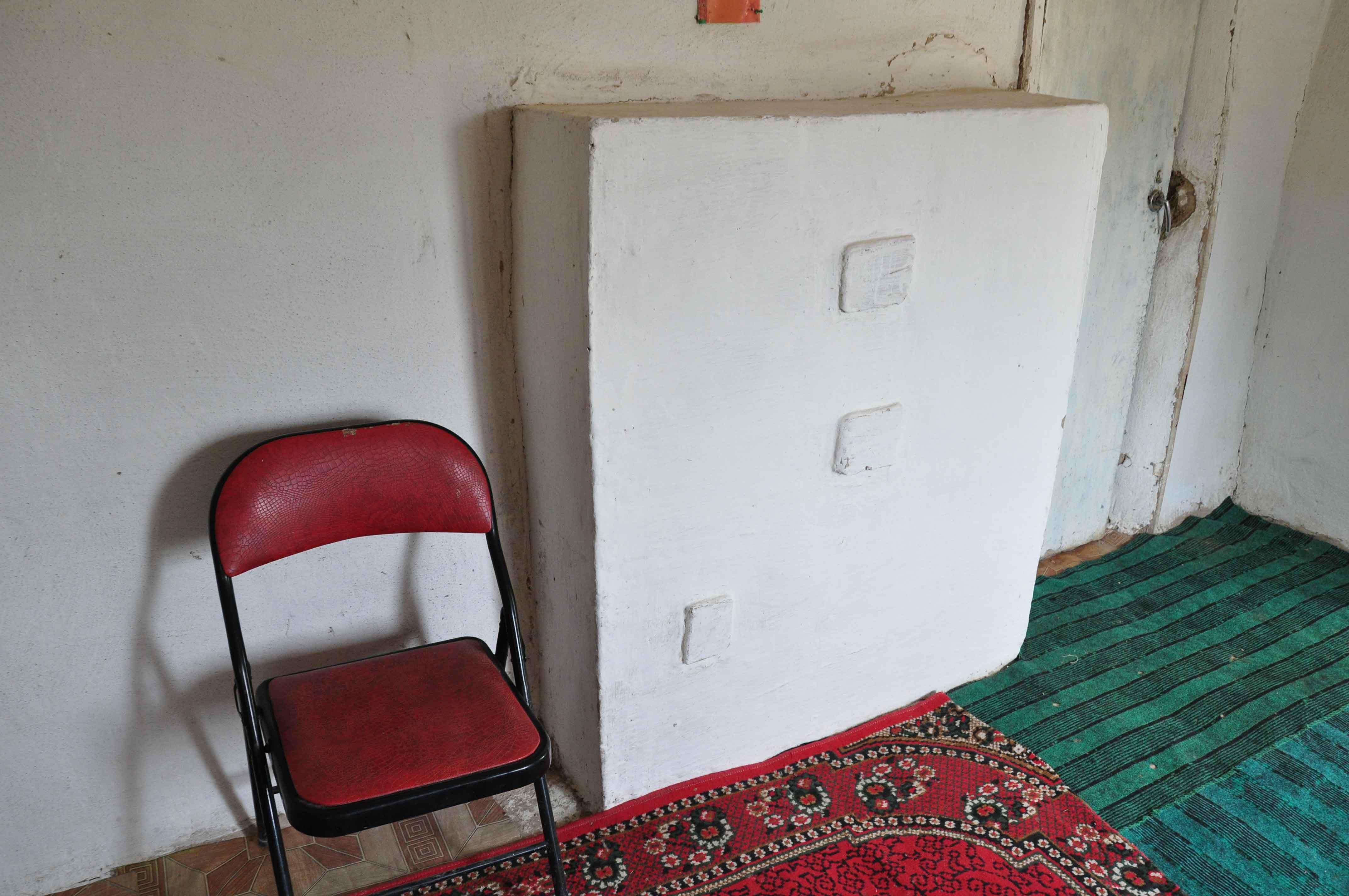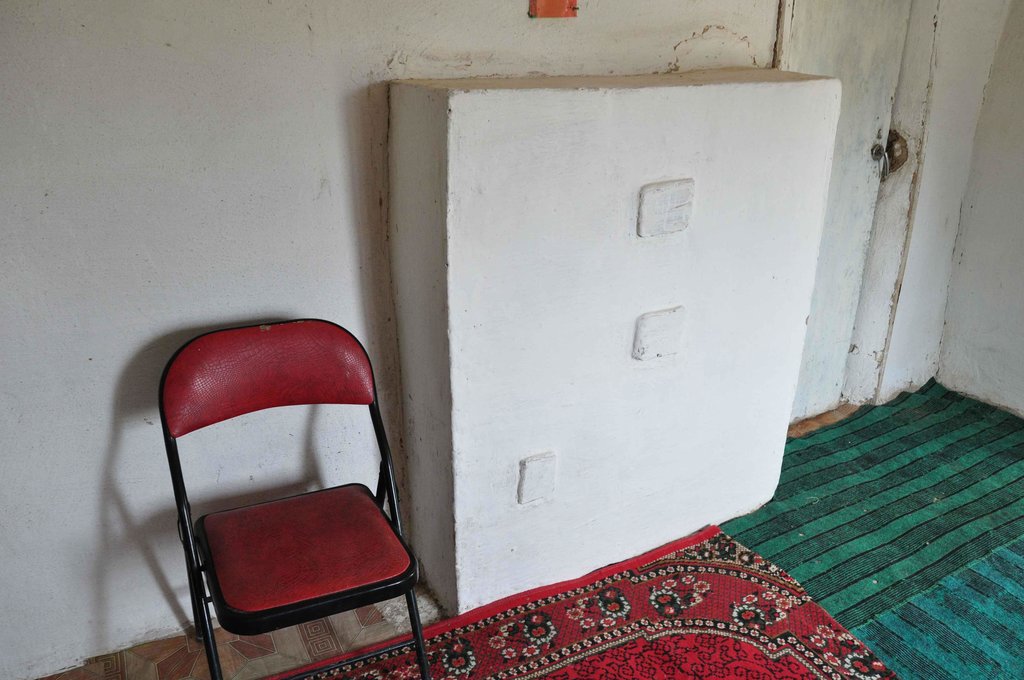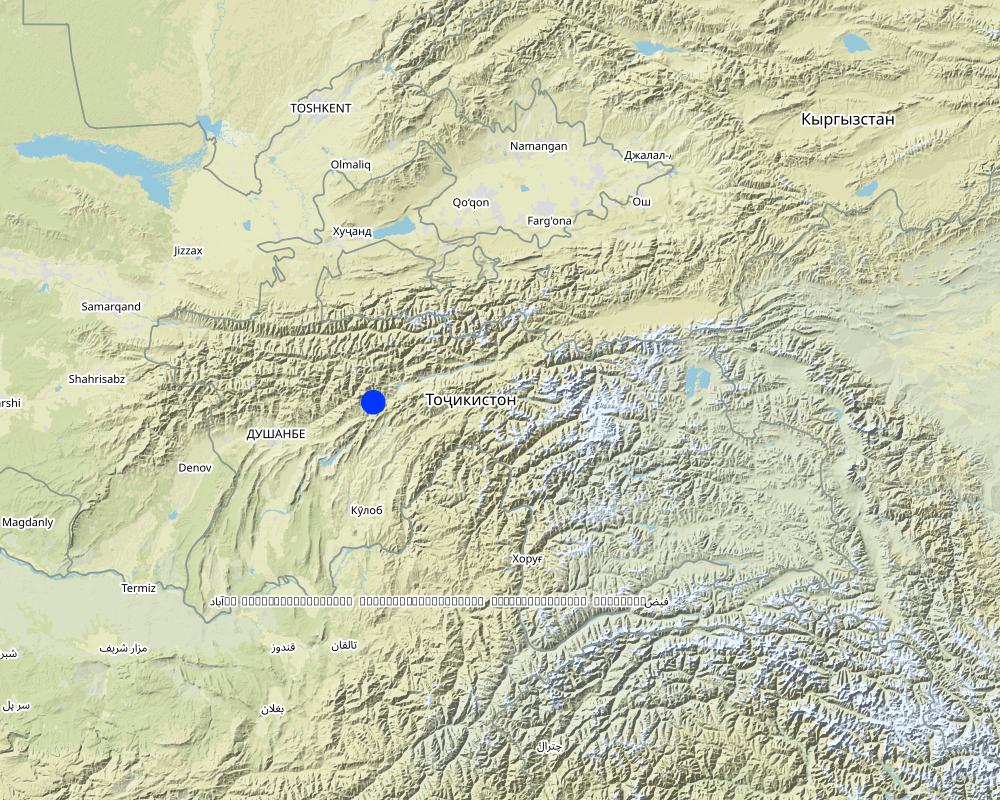Two Room Stove [Tajikistan]
- Creation:
- Update:
- Compiler: shane stevenson
- Editor: –
- Reviewers: Alexandra Gavilano, David Streiff, Joana Eichenberger
technologies_1518 - Tajikistan
View sections
Expand all Collapse all1. General information
1.2 Contact details of resource persons and institutions involved in the assessment and documentation of the Technology
SLM specialist:
Pochoev Mirzokurbon
CAMP
Tajikistan
Name of project which facilitated the documentation/ evaluation of the Technology (if relevant)
Pilot Program for Climate Resilience, Tajikistan (WB / PPCR)Name of the institution(s) which facilitated the documentation/ evaluation of the Technology (if relevant)
CAMP - Central Asian Mountain Partnership (CAMP - Central Asian Mountain Partnership) - Kyrgyzstan1.3 Conditions regarding the use of data documented through WOCAT
The compiler and key resource person(s) accept the conditions regarding the use of data documented through WOCAT:
Yes
1.5 Reference to Questionnaire(s) on SLM Approaches (documented using WOCAT)

Participatory Cost Benefit Analysis for Energy Efficiency Measures [Tajikistan]
The use of a cost benefit analysis approach to assess the financial and natural resource needs for energy consumption at community level, and further attribute costs to SLM practices to meet this need, and subsequently improve rural livelihoods.
- Compiler: shane stevenson
2. Description of the SLM Technology
2.1 Short description of the Technology
Definition of the Technology:
A brick stove that is built into the existing internal wall, that will heat the two rooms and can be used for cooking.
2.2 Detailed description of the Technology
Description:
The 2-room stove is a brick based structure that filters hot air into a second room, hence maximising the heating potential of the fuel. The basic stove is built of fire bricks, house bricks, cement and coated with a natural mix of straw and mud. It is a traditional concept based upon former soviet stoves, that was modernised and adapted to improve the energy efficiency, and make use of the materials that are available to the people. It is able to burn coal, wood, and tapac, and is designed to reduce the amount of natural resources used to meet the household energy needs.
Purpose of the Technology: The purpose of the 2-room stove is to replace the traditional cast iron pig style of stove, with a more modern and energy efficient stove that can be used effectively for cooking and the heating of two rooms. The 2-room stove is designed to filter the hot air between the rooms and the use the bricks as a thermal sink for heat retention. As most of the houses are made of mud bricks, the heat from the stove will conduct through the walls, which will act as radiators to emit warmth into the room. The 2-room stove also means that cooking activities can be conducted inside the house in a smoke free environment.
Establishment / maintenance activities and inputs: The stove requires basic training in construction by a skilled technician, however after a three day training course the local trades people are able to build their own stoves with limited supervision. The stove is constructed from 45 fire bricks and 400 household bricks, the hot plate and stove doors are bought second hand from the markets, and metal bars are used to reinforce the structure. There are two smoke vents in the wall between the two rooms to allow the smoke to filter its way along the snake like chimney until it vents through the roof. The final structure is coated in straw and mud which acts as an insulation layer.
Natural / human environment: There is a high reliance on natural resources in Shahtuti Bolo. The average family burns several tons of tapac (straw dung mix) and wood each year. The surrounding mountain area is sparsely vegetated and does not even provide enough fuel for the village during the harsh winter months. This is supplemented by buying wood from the neighbouring villages. One tapac weighs one kilo, this is organic matter that can no longer be used for soil enhancement, but for fuel purposes. It is estimated that the 2-room stove will reduce the amount of fuel burnt by 20-40% depending upon the household.
2.3 Photos of the Technology
2.5 Country/ region/ locations where the Technology has been applied and which are covered by this assessment
Country:
Tajikistan
Region/ State/ Province:
Hakimi Jamoat, Nurobod
Further specification of location:
Regional Subordination of Tajikistan
Specify the spread of the Technology:
- evenly spread over an area
If precise area is not known, indicate approximate area covered:
- 0.1-1 km2
Comments:
The village of Shahtuti Bolo
Map
×2.6 Date of implementation
If precise year is not known, indicate approximate date:
- less than 10 years ago (recently)
2.7 Introduction of the Technology
Specify how the Technology was introduced:
- through projects/ external interventions
Comments (type of project, etc.):
The two room stove is modernisation of a traditional design, therefore the concept is not new to the people.
3. Classification of the SLM Technology
3.1 Main purpose(s) of the Technology
- reduce energy
3.2 Current land use type(s) where the Technology is applied

Cropland
Number of growing seasons per year:
- 1
Specify:
Longest growing period in days: 180Longest growing period from month to month: April - October

Grazing land

Settlements, infrastructure
- Settlements, buildings
Remarks:
The technology is implemented in the households
Comments:
Major land use problems (compiler’s opinion): The over exploitation of natural resources that have lead to soil erosion and degradation of the soil structure.
Major land use problems (land users’ perception): The land has become increasingly unproductive over the last few decades. There is not enough pasture to feed our animals.
Constraints of settlement / urban
3.5 SLM group to which the Technology belongs
- energy efficiency technologies
3.6 SLM measures comprising the Technology

structural measures
- S11: Others
Comments:
Main measures: structural measures
3.7 Main types of land degradation addressed by the Technology

soil erosion by water
- Wt: loss of topsoil/ surface erosion
- Wg: gully erosion/ gullying
- Wm: mass movements/ landslides

soil erosion by wind
- Et: loss of topsoil

chemical soil deterioration
- Cn: fertility decline and reduced organic matter content (not caused by erosion)

biological degradation
- Bc: reduction of vegetation cover
- Bh: loss of habitats
- Bq: quantity/ biomass decline
Comments:
Main type of degradation addressed: Wt: loss of topsoil / surface erosion, Wg: gully erosion / gullying, Wm: mass movements / landslides, Et: loss of topsoil, Cn: fertility decline and reduced organic matter content, Bc: reduction of vegetation cover, Bh: loss of habitats
Secondary types of degradation addressed: Bq: quantity / biomass decline
Main causes of degradation: soil management (Failure to use organic fertilisers), deforestation / removal of natural vegetation (incl. forest fires) (Removal of natural resources to meet local energy needs.), over-exploitation of vegetation for domestic use (as above), overgrazing (Areas became over grazed as productivity declined), disturbance of water cycle (infiltration / runoff) (removal of vegetation leads to increased run off from the mountain slopes.), poverty / wealth (There is a lack of money for investment), labour availability (Two thirds of the households in the village have people working abroad.), war and conflicts (There has been substantial political unrest in the area.)
Secondary causes of degradation: Heavy / extreme rainfall (intensity/amounts) (There is a perception that there are more extreme rainfall events.), population pressure (Popualtion in the area is increasing), education, access to knowledge and support services (Lack of knowledge on good land management.)
3.8 Prevention, reduction, or restoration of land degradation
Specify the goal of the Technology with regard to land degradation:
- prevent land degradation
- reduce land degradation
Comments:
Main goals: mitigation / reduction of land degradation
Secondary goals: prevention of land degradation
4. Technical specifications, implementation activities, inputs, and costs
4.1 Technical drawing of the Technology
Technical specifications (related to technical drawing):
A simple view of the main part of the stove used for cooking. There are two cast iron doors, the lower is for air circulation and the upper is the combustion chamber for the fuel. There are two hot plates for cooking. The smoke travels from the fire vent towards the chimney and then through a 10cm sq hole to the brick structure on the other side. The smoke snakes it way around the the second structure which acts as a radiator as the bricks warm up. The smoke then returns into the chimney in the main room, heating the chimney as it vents.
Location: Shahtuti Bolo. Nurobod
Date: 13.07.2011
Technical knowledge required for field staff / advisors: high (The technical design requires a high level of knowledge)
Technical knowledge required for land users: moderate (With training the land user would be able to build their own two room stove)
Main technical functions: reduces the amount of dung and wood used as fuel.
Structural measure: 2-room stove
Construction material (other): fire bricks and regular house bricks, covered in mud are the main materials.
Author:
S. stevenson, CAMP Kuhiston, apt19 h 131 Rudaki ave, 734003, Dushanbe
4.2 General information regarding the calculation of inputs and costs
Specify how costs and inputs were calculated:
- per Technology unit
Specify unit:
Stove
Specify currency used for cost calculations:
- USD
Indicate average wage cost of hired labour per day:
4.00
4.3 Establishment activities
| Activity | Timing (season) | |
|---|---|---|
| 1. | Construction of stove | any |
| 2. | None | None |
4.4 Costs and inputs needed for establishment
| Specify input | Unit | Quantity | Costs per Unit | Total costs per input | % of costs borne by land users | |
|---|---|---|---|---|---|---|
| Labour | Construction of stove | Persons/day | 6.0 | 5.333333 | 32.0 | 100.0 |
| Equipment | Tools | pieces | 5.0 | 4.0 | 20.0 | |
| Construction material | Bricks | bricks | 400.0 | 0.225 | 90.0 | |
| Construction material | Fire bricks | bricks | 45.0 | 1.4 | 63.0 | |
| Construction material | Metal bar | bars | 5.0 | 3.4 | 17.0 | |
| Construction material | Fire cement | cub m | 3.0 | 8.333333 | 25.0 | |
| Construction material | Ceramic tiles | tiles | 24.0 | 1.0 | 24.0 | |
| Construction material | Metal cooking plates | plates | 1.0 | 63.0 | 63.0 | |
| Construction material | Stove doors | doors | 2.0 | 22.5 | 45.0 | |
| Other | Transports | vans | 1.0 | 50.0 | 50.0 | |
| Total costs for establishment of the Technology | 429.0 | |||||
| Total costs for establishment of the Technology in USD | 429.0 | |||||
Comments:
Duration of establishment phase: 1 month(s)
4.5 Maintenance/ recurrent activities
| Activity | Timing/ frequency | |
|---|---|---|
| 1. | Cleaning the stove | annually |
4.6 Costs and inputs needed for maintenance/ recurrent activities (per year)
| Specify input | Unit | Quantity | Costs per Unit | Total costs per input | % of costs borne by land users | |
|---|---|---|---|---|---|---|
| Labour | Cleaning the stove | Persons/day | 1.0 | 4.0 | 4.0 | 100.0 |
| Total costs for maintenance of the Technology | 4.0 | |||||
| Total costs for maintenance of the Technology in USD | 4.0 | |||||
Comments:
The costs are based upon 2011 prices and are based on constructing only one stove.
4.7 Most important factors affecting the costs
Describe the most determinate factors affecting the costs:
The main cost is the fire bricks. These have to be transported from the capital. However, in some regions of Tajikistan, materials are available from stoves that were constructed several decades ago which could be reused.
5. Natural and human environment
5.1 Climate
Annual rainfall
- < 250 mm
- 251-500 mm
- 501-750 mm
- 751-1,000 mm
- 1,001-1,500 mm
- 1,501-2,000 mm
- 2,001-3,000 mm
- 3,001-4,000 mm
- > 4,000 mm
Agro-climatic zone
- semi-arid
Thermal climate class: temperate
5.2 Topography
Slopes on average:
- flat (0-2%)
- gentle (3-5%)
- moderate (6-10%)
- rolling (11-15%)
- hilly (16-30%)
- steep (31-60%)
- very steep (>60%)
Landforms:
- plateau/plains
- ridges
- mountain slopes
- hill slopes
- footslopes
- valley floors
Altitudinal zone:
- 0-100 m a.s.l.
- 101-500 m a.s.l.
- 501-1,000 m a.s.l.
- 1,001-1,500 m a.s.l.
- 1,501-2,000 m a.s.l.
- 2,001-2,500 m a.s.l.
- 2,501-3,000 m a.s.l.
- 3,001-4,000 m a.s.l.
- > 4,000 m a.s.l.
Indicate if the Technology is specifically applied in:
- not relevant
5.3 Soils
Soil depth on average:
- very shallow (0-20 cm)
- shallow (21-50 cm)
- moderately deep (51-80 cm)
- deep (81-120 cm)
- very deep (> 120 cm)
Soil texture (topsoil):
- coarse/ light (sandy)
Topsoil organic matter:
- low (<1%)
If available, attach full soil description or specify the available information, e.g. soil type, soil PH/ acidity, Cation Exchange Capacity, nitrogen, salinity etc.
Soil fertility is low - medium
Soil drainage / infiltration is poor
Soil water storage capacity is low-medium
5.4 Water availability and quality
Ground water table:
< 5 m
Availability of surface water:
poor/ none
Water quality (untreated):
poor drinking water (treatment required)
Comments and further specifications on water quality and quantity:
Availability of surface water: is good for the village because there is a stream and medium for other areas which have access to te stream.
5.5 Biodiversity
Species diversity:
- low
5.6 Characteristics of land users applying the Technology
Off-farm income:
- 10-50% of all income
Relative level of wealth:
- very poor
- poor
Individuals or groups:
- individual/ household
Gender:
- women
- men
Indicate other relevant characteristics of the land users:
Land users applying the Technology are mainly disadvantaged land users
Difference in the involvement of women and men: Training is provided on he construction of the stove. This is only attended by men.
Population density: 50-100 persons/km2
Annual population growth: 2% - 3%
80% of the land users are poor and own 95% of the land.
20% of the land users are poor and own 5% of the land.
Off-farm income specification: 44 out of the 58 households are reliant on remittances from Russia, however all the families have livestock which they buy and sell in the local markets and a small household plot for vegetables.
5.7 Average area of land used by land users applying the Technology
- < 0.5 ha
- 0.5-1 ha
- 1-2 ha
- 2-5 ha
- 5-15 ha
- 15-50 ha
- 50-100 ha
- 100-500 ha
- 500-1,000 ha
- 1,000-10,000 ha
- > 10,000 ha
Is this considered small-, medium- or large-scale (referring to local context)?
- small-scale
5.8 Land ownership, land use rights, and water use rights
Land ownership:
- state
Land use rights:
- communal (organized)
Comments:
Four people have the majority of the land user rights in a village of 58.
5.9 Access to services and infrastructure
health:
- poor
- moderate
- good
education:
- poor
- moderate
- good
technical assistance:
- poor
- moderate
- good
employment (e.g. off-farm):
- poor
- moderate
- good
markets:
- poor
- moderate
- good
energy:
- poor
- moderate
- good
roads and transport:
- poor
- moderate
- good
drinking water and sanitation:
- poor
- moderate
- good
financial services:
- poor
- moderate
- good
6. Impacts and concluding statements
6.1 On-site impacts the Technology has shown
Socio-economic impacts
Production
crop production
wood production
energy generation
Comments/ specify:
Improved cooking conditions i.e. no smoke.
Income and costs
workload
Other socio-economic impacts
Demand on natural resources
Comments/ specify:
On average around 30% reduction
Socio-cultural impacts
health situation
Comments/ specify:
Do not need to cook outside and improve the internal living conditions.
community institutions
Comments/ specify:
Leaves natural resources for the community benefit.
conflict mitigation
Comments/ specify:
Helps prevent inter village conflicts over natural resources.
situation of socially and economically disadvantaged groups
Comments/ specify:
The project is targeted at the most vulnerable in the community.
Livelihood and human well-being
Comments/ specify:
It has reduced the time, effort and money spent on fuel whcih can be up to 50% of the household's budget in extreme cases. It has improved the heating in the household and created a smoke free environment for cooking.
Ecological impacts
Soil
soil cover
Biodiversity: vegetation, animals
biomass/ above ground C
Comments/ specify:
Reduction in the burning of dung.
6.3 Exposure and sensitivity of the Technology to gradual climate change and climate-related extremes/ disasters (as perceived by land users)
Gradual climate change
Gradual climate change
| Season | increase or decrease | How does the Technology cope with it? | |
|---|---|---|---|
| annual temperature | increase | well |
Climate-related extremes (disasters)
Meteorological disasters
| How does the Technology cope with it? | |
|---|---|
| local rainstorm | well |
| local windstorm | well |
Climatological disasters
| How does the Technology cope with it? | |
|---|---|
| drought | well |
Hydrological disasters
| How does the Technology cope with it? | |
|---|---|
| general (river) flood | well |
Other climate-related consequences
Other climate-related consequences
| How does the Technology cope with it? | |
|---|---|
| reduced growing period | well |
Comments:
The stove is able to take other fuel sources in the event that natural resources are not available.
6.4 Cost-benefit analysis
How do the benefits compare with the establishment costs (from land users’ perspective)?
Short-term returns:
negative
Long-term returns:
very positive
How do the benefits compare with the maintenance/ recurrent costs (from land users' perspective)?
Short-term returns:
neutral/ balanced
Long-term returns:
positive
Comments:
There is a high initial outlay in the building materials and labour costs, but once the two room stove is constructed it only requires annual cleaning which can be done via hatches already included in the design.
6.5 Adoption of the Technology
- 1-10%
If available, quantify (no. of households and/ or area covered):
10 households in an area of 0.1 - 1 km2 (ca. 596 habitants)
Of all those who have adopted the Technology, how many did so spontaneously, i.e. without receiving any material incentives/ payments?
- 0-10%
Comments:
100% of land user families have adopted the Technology with external material support
Comments on acceptance with external material support: All land users given support have constructed a stove. The project will build a further 11 stoves in the local district for the most vulnerable families.
There is no trend towards spontaneous adoption of the Technology
Comments on adoption trend: To early in the project to say, but several memebers of the community are trained to build the stove.
6.7 Strengths/ advantages/ opportunities of the Technology
| Strengths/ advantages/ opportunities in the land user’s view |
|---|
|
It keep the house warm and for longer. How can they be sustained / enhanced? Thermal insulation techniques and energy efficiency training may support reduced fuel use. |
| I do not have to cook outside in the winter months. |
| It is easy to clean. |
| Strengths/ advantages/ opportunities in the compiler’s or other key resource person’s view |
|---|
|
It improved the household heating system dramatically, as the previous cast iron stove does not retain the heat after the fire dies. How can they be sustained / enhanced? The room could be insulated using traditional techniques or modern materials that are starting to appear on the market. |
|
The brick design will retain the heat for several hours and will heat two rooms. How can they be sustained / enhanced? Doors and windows in the rooms could be sealed to prevent drafts. |
|
The stove will last for 25yrs with minimal maintenance. How can they be sustained / enhanced? If the stove became popular a small brick making factory could be established. |
6.8 Weaknesses/ disadvantages/ risks of the Technology and ways of overcoming them
| Weaknesses/ disadvantages/ risks in the land user’s view | How can they be overcome? |
|---|---|
| It is expensive, and I need an expert to help me. | Remittances could be used to fund the initial set up costs. |
| Weaknesses/ disadvantages/ risks in the compiler’s or other key resource person’s view | How can they be overcome? |
|---|---|
| There is a high initial investment that has required project funding. | Collective building of the stoves will reduce the cost. Micro-finance loans could be made available to help cover the initial costs. |
| The stove requires technical training in its construction. | A booklet could be produced to support self building of the stoves. |
7. References and links
7.1 Methods/ sources of information
Links and modules
Expand all Collapse allLinks

Participatory Cost Benefit Analysis for Energy Efficiency Measures [Tajikistan]
The use of a cost benefit analysis approach to assess the financial and natural resource needs for energy consumption at community level, and further attribute costs to SLM practices to meet this need, and subsequently improve rural livelihoods.
- Compiler: shane stevenson
Modules
No modules





